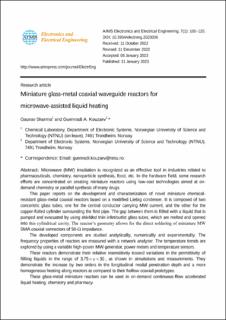| dc.contributor.author | Sharma, Gaurav | |
| dc.contributor.author | Kouzaev, Guennadi | |
| dc.date.accessioned | 2023-02-13T13:01:11Z | |
| dc.date.available | 2023-02-13T13:01:11Z | |
| dc.date.created | 2023-02-03T11:49:15Z | |
| dc.date.issued | 2023 | |
| dc.identifier.citation | AIMS Electronics and Electrical Engineering. 2023, 7 (1), 100-120. | en_US |
| dc.identifier.issn | 2578-1588 | |
| dc.identifier.uri | https://hdl.handle.net/11250/3050410 | |
| dc.description.abstract | Microwave (MW) irradiation is recognized as an effective tool in industries related to pharmaceuticals, chemistry, nanoparticle synthesis, food, etc. In the hardware field, some research efforts are concentrated on creating miniature reactors using low-cost technologies aimed at on-demand chemistry or parallel synthesis of many drugs. This paper reports on the development and characterization of novel miniature chemical-resistant glass-metal coaxial reactors based on a modified Liebig condenser. It is composed of two concentric glass tubes, one for the central conductor carrying MW current, and the other for the copper-foiled cylinder surrounding the first pipe. The gap between them is filled with a liquid that is pumped and evacuated by using shielded thin inlet/outlet glass tubes, which are melted and opened into this cylindrical cavity. The reactor's geometry allows for the direct soldering of miniature MW SMA coaxial connectors of 50-Ω impedance. The developed components are studied analytically, numerically and experimentally. The frequency properties of reactors are measured with a network analyzer. The temperature trends are explored by using a variable high-power MW generator, power meters and temperature sensors. These reactors demonstrate their relative insensitivity toward variations in the permittivity of filling liquids in the range of 3.75<ε<30, as shown in simulations and measurements. They demonstrate the increase by two orders in the longitudinal modal penetration depth and a more homogeneous heating along reactors as compared to their hollow coaxial prototypes. These glass-metal miniature reactors can be used in on-demand continuous-flow accelerated liquid heating, chemistry and pharmacy. | en_US |
| dc.description.abstract | Miniature glass-metal coaxial waveguide reactors for microwave-assisted liquid heating | en_US |
| dc.language.iso | eng | en_US |
| dc.relation.uri | https://www.aimspress.com/article/doi/10.3934/electreng.2023006 | |
| dc.rights | Navngivelse 4.0 Internasjonal | * |
| dc.rights.uri | http://creativecommons.org/licenses/by/4.0/deed.no | * |
| dc.title | Miniature glass-metal coaxial waveguide reactors for microwave-assisted liquid heating | en_US |
| dc.title.alternative | Miniature glass-metal coaxial waveguide reactors for microwave-assisted liquid heating | en_US |
| dc.type | Journal article | en_US |
| dc.description.version | acceptedVersion | en_US |
| dc.source.pagenumber | 100-120 | en_US |
| dc.source.volume | 7 | en_US |
| dc.source.journal | AIMS Electronics and Electrical Engineering | en_US |
| dc.source.issue | 1 | en_US |
| dc.identifier.doi | https://doi.org/10.3934/electreng.2023006 | |
| dc.identifier.cristin | 2122742 | |
| cristin.ispublished | true | |
| cristin.fulltext | postprint | |

